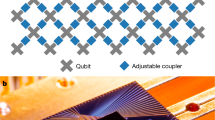Abstract
Information theory establishes the ultimate limits on performance for noisy communication systems1. Accurate models of physical communication devices must include quantum effects, but these typically make the theory intractable2,3,4,5. As a result, communication capacities—the maximum possible rates of data transmission—are not known, even for transmission between two users connected by an electromagnetic waveguide with Gaussian noise6. Here we present an exactly solvable model of communication with a fully quantum electromagnetic field. This gives explicit expressions for all point-to-point capacities of noisy quantum channels, with implications for quantum key distribution and fibre-optic communications. We also develop a theory of quantum communication networks by solving some rudimentary models including broadcast and multiple-access channels. We compare the predictions of our model with the orthodox Gaussian model and in all cases find agreement to within a few bits. At high signal-to-noise ratios, our simple model captures the relevant physics while remaining amenable to exact solution.
This is a preview of subscription content, access via your institution
Access options
Subscribe to this journal
Receive 51 print issues and online access
$199.00 per year
only $3.90 per issue
Buy this article
- Purchase on Springer Link
- Instant access to full article PDF
Prices may be subject to local taxes which are calculated during checkout




Similar content being viewed by others
References
Shannon, C. E. A mathematical theory of communication. Bell Syst. Tech. J. 27, 379–423, 623–656 (1948)
Gordon, J. P. in Quantum Electronics and Coherent Light (ed. Miles, P. A. ) 156 (1964)
Holevo, A. S. in Proc. 2nd Jpn–USSR Symp. Probability Theory (eds Maruyama, G. & Prokhorov, J. V. ) 104–119 (Lect. Notes Math. 330, Springer, 1973)
Schumacher, B. & Westmoreland, M. D. Sending classical information via noisy quantum channels. Phys. Rev. A 56, 131–138 (1997)
Holevo, A. S. The capacity of a quantum channel with general signal states. IEEE Trans. Inf. Theory 44, 269–273 (1998)
Holevo, A. S. & Werner, R. F. Evaluating capacities of bosonic gaussian channels. Phys. Rev. A 63, 032312 (2001)
Richardson, T. & Urbanke, R. The renaissance of Gallager’s low-density parity-check codes. IEEE Commun. Mag. 41, 126–131 (2003)
Devetak, I. The private classical capacity and quantum capacity of a quantum channel. IEEE Trans. Inf. Theory 51, 44–55 (2005)
Lloyd, S. Capacity of the noisy quantum channel. Phys. Rev. A 55, 1613–1622 (1997)
Shor, P. W. & Smolin, J. A. Quantum error-correcting codes need not completely reveal the error syndrome. Preprint at http://arxiv.org/abs/quant-ph/9604006 (1996)
DiVincenzo, D., Shor, P. W. & Smolin, J. A. Quantum channel capacity of very noisy channels. Phys. Rev. A 57, 830–839 (1998)
Hastings, M. B. Superadditivity of communication capacity using entangled inputs. Nature Phys. 5, 255–257 (2009)
Smith, G., Renes, J. M. & Smolin, J. A. Structured codes improve the Bennett-Brassard-84 quantum key rate. Phys. Rev. Lett. 100, 170502 (2008)
Wootters, W. K. & Zurek, W. H. A single quantum cannot be cloned. Nature 299, 802–803 (1982)
Cover, T. M. Comments on broadcast channels. IEEE Trans. Inf. Theory 44, 2524–2530 (1998)
Avestimehr, S., Diggavi, S. & Tse, D. in Proc. Allerton Conf. Commun. Control Comput. 721–728 (IEEE, 2007)
Eisert, J. & Wolf, M. M. in Quantum Information with Continuous Variables of Atoms and Light (eds Cerf, N. J., Leuchs, G. & Polzik, E. S. ) 23–42 (Imperial Coll. Press, 2007)
Giovannetti, V. et al. Classical capacity of the lossy bosonic channel: the exact solution. Phys. Rev. Lett. 92, 027902 (2004)
Wolf, M. M. Perez-Garcia, D. & Giedke, G. Quantum capacities of bosonic channels. Phys. Rev. Lett. 98, 130501 (2007)
Wilde, M. M. Hayden, P. & Guha, S. Information trade-offs for optical quantum communication. Phys. Rev. Lett. 108, 140501 (2012)
Cover, T. M. &. Thomas, J. A. Elements of Information Theory 374–458 (Wiley, 1991)
El Gamal, A. & Kim, Y.-H. Network Information Theory (Cambridge Univ. Press, 2011)
Horodecki, K., Horodecki, M., Horodecki, P. & Oppenheim, J. Secure key from bound entanglement. Phys. Rev. Lett. 94, 160502 (2005)
Bennett, C. H., DiVincenzo, D. P., Smolin, J. A. & Wootters, W. K. Mixed state entanglement and quantum error correction. Phys. Rev. A 54, 3824–3851 (1996)
Smith, G. & Yard, J. Quantum communication with zero-capacity channels. Science 351, 1812–1815 (2008)
Smith, G. & Smolin, J. A. Extensive nonadditivity of privacy. Phys. Rev. Lett. 103, 120503 (2009)
Smith, G., Smolin, J. A. & Yard, J. Gaussian bosonic synergy: quantum communication via realistic channels of zero quantum capacity. Nature Photon. 5, 624–627 (2011)
Yen, B. J. & Shapiro, J. H. Multiple-access bosonic communications. Phys. Rev. A 72, 062312 (2005)
Guha, S., Shapiro, J. H. & Erkmen, B. I. Classical capacity of bosonic broadcast communication and a minimum output entropy conjecture. Phys. Rev. A 76, 032303 (2007)
Acknowledgements
This work was supported by the DARPA QUEST programme under contract no. HR0011-09-C-0047.
Author information
Authors and Affiliations
Contributions
G.S. and J.A.S. designed the research and carried out the research and computations. Both authors wrote the paper.
Corresponding author
Ethics declarations
Competing interests
The authors declare no competing financial interests.
Supplementary information
Supplementary Information
This file contains Supplementary Text and Data, Supplementary Figures 1-3 and additional references. (PDF 277 kb)
Rights and permissions
About this article
Cite this article
Smith, G., Smolin, J. An exactly solvable model for quantum communications. Nature 504, 263–267 (2013). https://doi.org/10.1038/nature12669
Received:
Accepted:
Published:
Issue Date:
DOI: https://doi.org/10.1038/nature12669
Comments
By submitting a comment you agree to abide by our Terms and Community Guidelines. If you find something abusive or that does not comply with our terms or guidelines please flag it as inappropriate.



